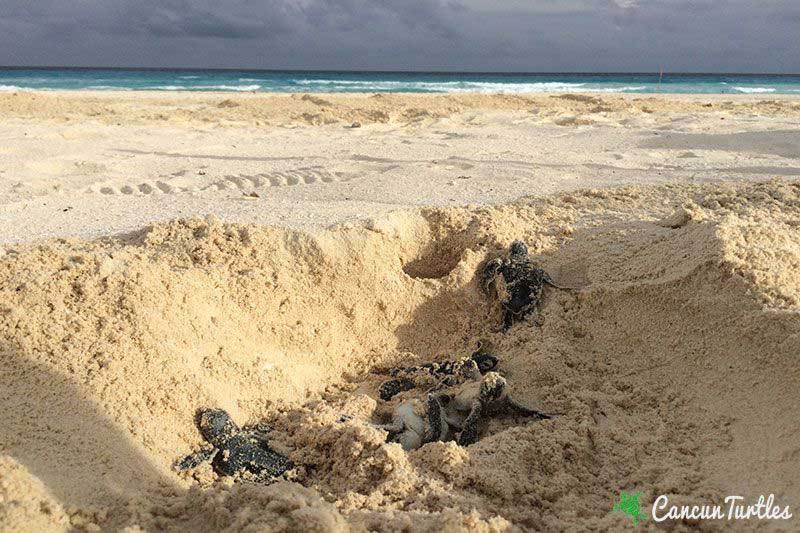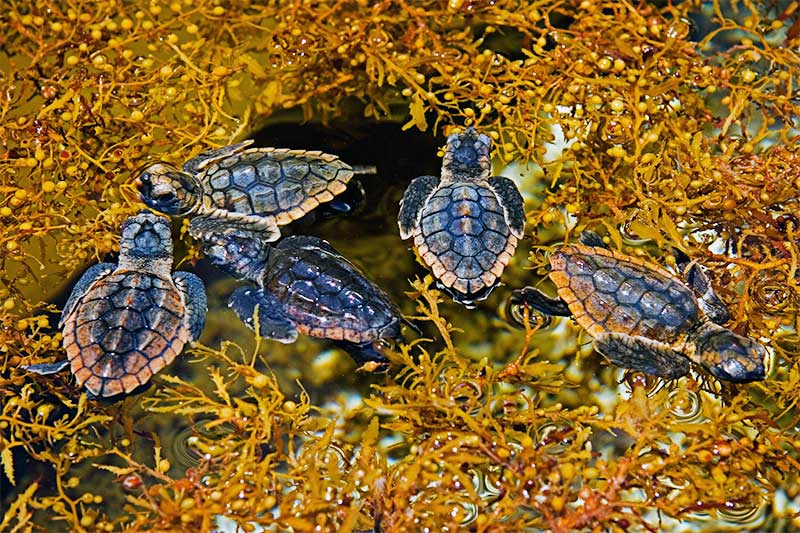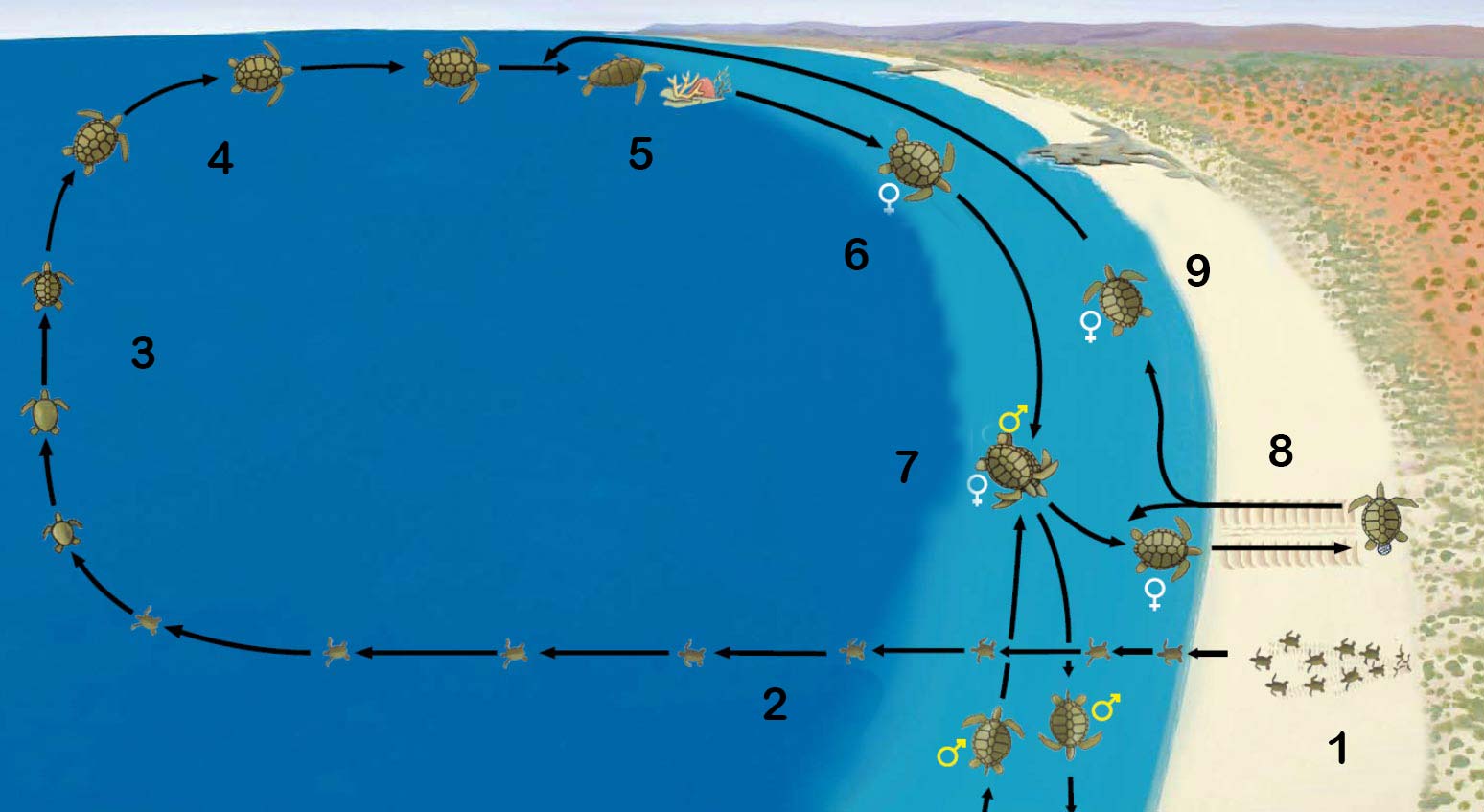The turtle’s most obvious physical attribute is its shell. Other prehistoric reptiles developed similar shells, but for whatever reason did not survive and diversify in how turtles did. The shell which in most turtles comprises two hard plates, protects the turtle’s vulnerable body from predators, retards desiccation in dry environments, and can even allow the turtle to survive a fire.
It can protect against trampling by grazing animals, serve as a weapon during competition for mates, or act as a digging tool when the turtle excavates burrows in which to rest. The shell is also a storehouse for the minerals that freshwater turtles need to survive a winter beneath the ice in frozen ponds. For sea turtles, the shell serves as a fairing, like those encasing racing motorcycles, to reduce drag as the turtle moves through the water.
The turtle’s shell is composed of two parts: the upper shell, or carapace, rests on the turtle’s back; and the lower shell, or plastron, covers its underside. The shell itself is a layered composite, yielding a high strength-to-weight ratio. The shell’s inner layer comprises bone plates, while the outer layer consists of plates made of keratin, the protein found in hair, fingernails, snake scales, bird feathers, and animal horns. These keratin plates, known as scutes, are equivalent to scales on other reptiles. Sea turtles (except leatherbacks) also have scales on the head, flippers, and other skin surfaces. The number and arrangement of the scutes on the shell and scales on the head are useful for identifying sea turtles by species, and even individuals within a species. We have a great overview of the scutes important for species identification: Identifying Sea Turtles.
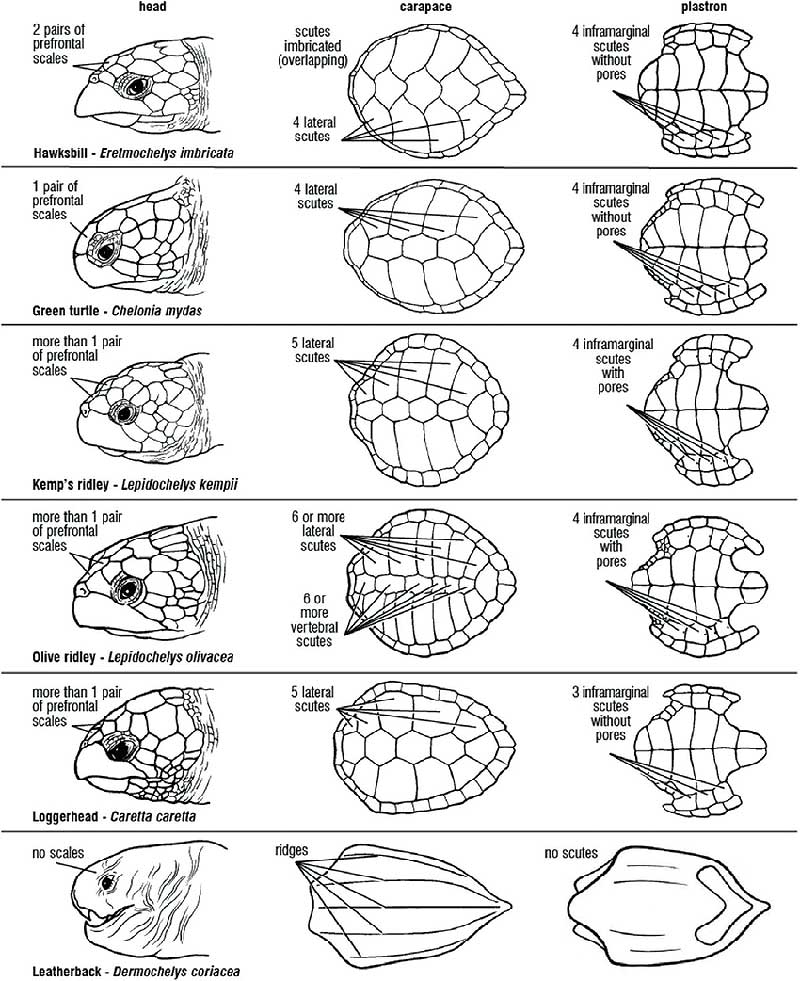
Overview of the differences in scutes patterns on the head, carapace and plastron of Sea Turtles.
The leatherback turtle, which, as you may recall, is in a family separate from all other sea turtles, has a carapace formed mostly of oily connective tissue that is covered with rubber-like skin. Embedded in the skin's underside is a thin mosaic-like layer of thousands of tiny polygon-shaped bone plates. Baby leatherbacks are covered with tiny scales, but adults have naked leathery skin.
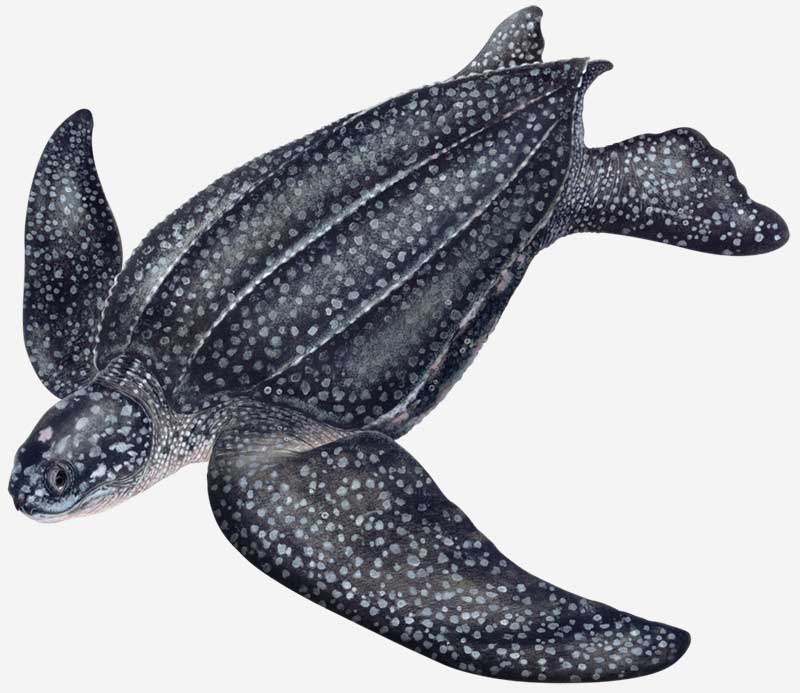
The ribbed design of the leatherback’s carapace, which is similar to some boat halls, may provide a hydrodynamic or stabilizing advantage as this open ocean behemoth traverses entire ocean basins and dives thousands of feet deep in its search for food.
The bony plates in the upper shell’s underlayer are joined and buttressed by the ribs and backbone, which are fused to the underside of the carapace (Again, the leatherback is an exception). Its ribs and vertebrae lie just under the carapace but are not integrated with it. As with humans and other mammals, the ribs protect the turtle’s internal organs such as the heart and lungs, but turtles are unusual in that their pelvic and shoulder bones are within the ribs.
The shoulder and hip girdles support fore and hind limbs that contain essentially the same bones found in our own limbs, including five digits. The bones are hidden inside flippers, which are strengthened and stiffened with fibrous connective tissue. The fore flippers and the toe bones inside of them are greatly elongated. The rear flippers are smaller and more flexible. Freshwater turtles swim primarily by kicking with their rear flippers. Sea turtles sometimes paddle with the rear flippers, but usually they hold the rear flippers behind them to use as rudders for steering. The rear flippers can also function like elevator fins on airplanes to trim the head up or down as the turtle moves forward.
Most of the propulsion comes from the fore flippers, which are shaped like airplane wings. When sea turtles swim, they flap the fore flippers up and down in a figure-eight pattern, enabling them to “fly” through the water like a penguin. Leatherbacks pull their flippers back and down, rather than back and up like all other sea turtles. As they pull the flippers forward, water flow over the flippers creates lift, just as airflow over an airplane wing lifts it and pulls it forward. When the sea turtle pushes the flippers back again, the flippers push against the resistance of the water to drive the turtle forward.
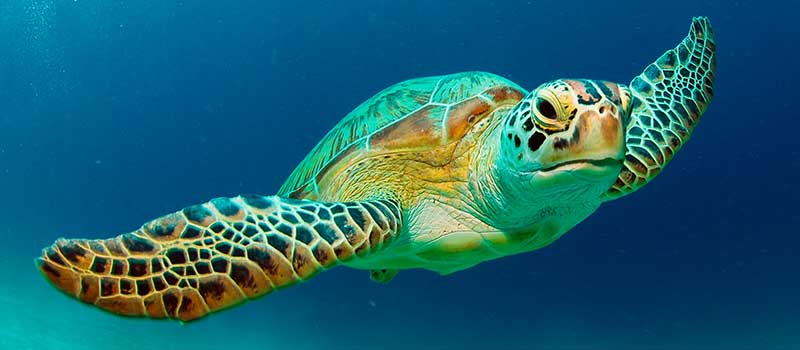
The fore flippers of sea turtles like this Green Sea Turtle function according to Bernoulli’s Principle, which states that an increase in the speed of a fluid results in a decrease in its pressure. Water must accelerate to pass around the thick, front edge and curved, upper surface of the flipper, creating an area of low pressure in front of and above the fin relative to the thinner trailing edge and flatter underside. This low pressure pulls the turtle forward and upward.
When females come ashore to nest, they use their flippers to haul themselves up the beach. They use their fore flippers to clear away a body pit and then, using the more flexible hind flippers, they excavate the egg chamber. Terrestrial and freshwater turtles have a claw at the end of each toe, but sea turtles have no more than two claws along the edge of each flipper. Leatherbacks have no flipper claws, while hawksbills and loggerheads have two on each flipper, and all other sea turtles have one claw per flipper. The forward claw on the fore flipper is longer and more curved in males, which use it as a hook to grasp the edge of the female’s carapace during mating.
Although sea turtles belong to the “hidden neck” group of turtles, they cannot retract their heads inside their shells as other members of this group can. Perhaps to compensate for this inability, the skull bones of sea turtles are heavy and fused solid. Sea turtles have openings for the eyes, ears, and nostrils, but the large openings found in the upper skull of other modern reptiles are missing. At one time, this led biologists to classify turtles with the extinct anapsids - the most primitive reptiles. Some biologists now believe that turtles are derived from the diapsid reptiles, which normally have two sizeable holes in the upper skull, but have lost the holes, perhaps as an adaptation to aquatic living.
Turtles have no teeth, but the horny beak has a sharp edge capable of biting into or breaking open a variety of foodstuffs. In green turtles, the lower beak has tooth-like serrations. This may be an adaptation for snipping off blades of seagrass (adult green turtles are the only herbivorous sea turtles). Leatherbacks have a deep notch in the upper jaw corresponding to a point on the lower beak - possibly an adaptation for feeding on jellyfish.
Internal Systems of Sea Turtles
In most aspects, the internal organs and physiology of sea turtles are like those of other reptiles. The saltwater environment, however, requires special adaptations, including the need to eliminate excess salt from the body. The seawater in which sea turtles live and the food they consume contain about three times as much salt as the turtle’s own body fluids. Marine reptiles have developed a variety of ways to remove the excess salt from their bodies. Marine iguanas, for example, excrete salt through a gland in the nose, “sneezing” it out of their bodies. Estuarine crocodiles excrete salt through a gland on the tongue and eliminate it through the mouth. Sea turtles, however, excrete excess salt through their salt glands - evolutionarily changed tear glands - in the form of brine. Twice as salty as seawater, the brine “weeps” from their eyes. These salt glands are so important to the sea turtle’s survival that they are the largest organs in the skull - many times larger than the tiny brain.
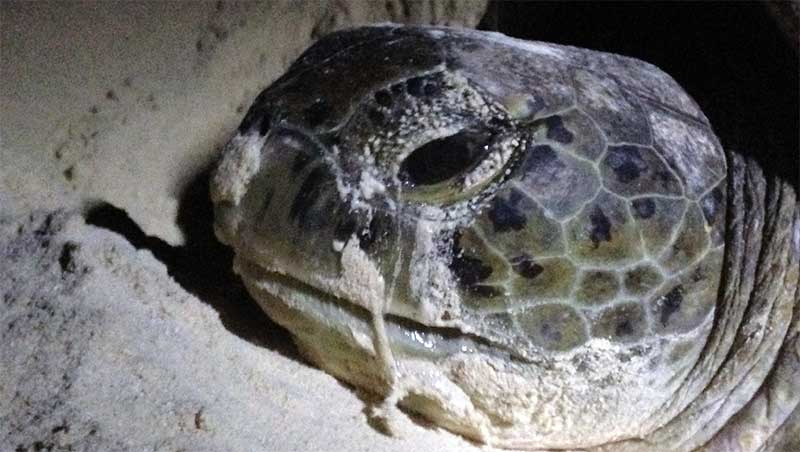
Briny secretions twice as salty as seawater flow from the eyes of sea turtles to eliminate the excess salt they absorb from their environment. When females come ashore, like this Green Sea Turtle nesting in Cancun - Mexico, they appear to have “tears” oozing from their eyes. Contrary to folklore that the turtles are crying because they will never see their babies, these tears have nothing to do with their emotional state.
The lungs of sea turtles differ from other reptiles. On top of the turtle’s body, just underneath the carapace, the lungs are reinforced with cartilage and elastic muscle tissue, and have large, stiff bronchial passageways. To get oxygen, sea turtles must draw air into their lungs with a few rapid breaths through the mouth. With each breath, a sea turtle can exchange 80 percent or more of the air in its lungs. This is a much higher percentage than other reptiles (or humans, who exchange only about 10 percent). The lungs of sea turtles are also much more efficient at transferring oxygen into the blood than most reptiles. Gas transfer between the blood and the lungs occurs only in the soft parts of the lung and not in the stiff passageways. During deep dives, the soft parts of the lungs collapse, forcing air into the rigid, non-absorptive passageways. This helps sea turtles avoid a deadly condition known as “the bends” that occurs in human divers. Laboratory tests have shown that sea turtles can develop the bends from extreme dives, but we do not know it to occur in nature.
After diving for half an hour, a sea turtle typically spends less than a minute at the surface before submerging again. During this time, it must take in all the oxygen it needs for the next dive. Sea turtles may spend 96 percent or more of their time submerged. Typical dive times range from about ten minutes to longer than an hour. Dives as long as five hours have been recorded in the wild, but some longer dive records may represent failures of the measuring or transmitting equipment. In the laboratory, green turtles have survived for up to six hours without breathing. We can say for certain that some sea turtles dive for as long as three hours under normal circumstances and can go without oxygen for longer.
Normally, turtles fuel their metabolism and activities with oxygen, like most other animals. When necessary, however, they can switch to anaerobic metabolism, which allows them to operate their bodies for hours without oxygen. Humans and other animals keep muscles operating with anaerobic metabolism when the ability of the blood to supply oxygen to the muscles has been exceeded. But in most vertebrates the ability of tissues to function temporarily without oxygen does not extend to the brain. If the brain is deprived of oxygen for more than a few minutes, death will result. Scientists have proven that loggerhead sea turtles and some freshwater turtles can reduce their brain function to a level that can be met by anaerobic metabolism (Scientists have not yet studied all aquatic turtles, but it is likely that many have the same ability). This apparently enables some freshwater turtles to hibernate under the ice throughout the winter. Turtles caught in trawl nets or otherwise forcibly held underwater, however, usually struggle and exceed the capacity of this system. They often drown in much less time than they might voluntarily dive.
The maximum depth to which sea turtles can dive is unknown. Only recently have scientists attached devices that can take these measurements. Green turtles can dive to at least 110m (360 feet), loggerheads to at least 230m (750 feet), and Olive Ridleys to at least 290m (950 feet). Leatherbacks are among the deepest diving of all air-breathing animals and can dive to more than 1,200m (3,900 feet). Leatherbacks have the highest concentrations of red blood cells, hemoglobin, and myoglobin of any reptile. This enables them to store sizeable amounts of oxygen in their blood and tissues - even more than in their lungs, which collapse when they dive. Shallow diving turtles keep air in their lungs while diving and get most of their oxygen from their lungs while they are underwater.
Body Temperature and Range of Sea Turtles
We consider reptiles being “cold-blooded” or ectothermic, meaning that their body temperature varies with the external environment. To a certain extent, they can control their body temperature through their behavior. By moving from the shade into the sun, for example, reptiles can raise their body temperature. Green turtles sometimes crawl out of the water and lie on beaches or rocks for hours. Scientists speculate that these turtles may sometimes do this to warm themselves, but that there may be other reasons for this behavior. Olive Ridleys and loggerheads sometimes float at the surface for hours on calm days, probably to absorb the sun’s heat through their exposed carapaces.
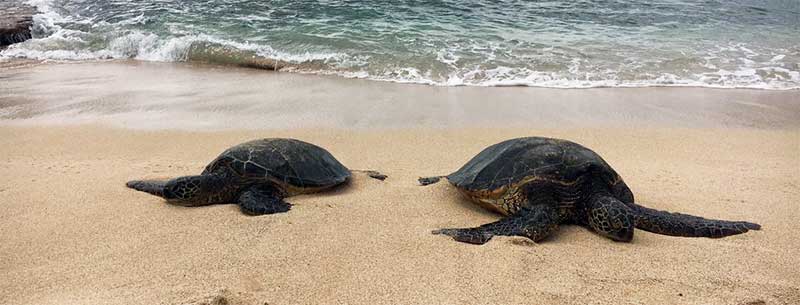
Green turtles are the only sea turtles known to leave the water for purposes other than nesting. This only occurs in a few locations, including the Galapagos Islands, where this pair is basking. One possible function of this behavior is to raise body temperature, enabling digestion, egg maturation, and other body functions to proceed at a faster rate.
Green sea turtles, when swimming actively, may raise their body temperature as much as 8° C (14°F) above the water temperature. When inactive, however, green turtles, like loggerheads and Olive Ridleys, have a body temperature within 2°C (4°F) of the water temperature.
The need to keep body temperature within safe limits may affect many aspects of sea turtle behavior, especially nesting. Cold water temperatures can lead to cold stunning and death, while high temperatures, such as those a female might encounter if trapped on a hot beach after nesting, can cause overheating and death. For this reason, most sea turtles are limited to tropical and warm temperate seas and nest primarily at night. Leatherbacks, however, can migrate into cold, high-latitude seas and dive into cold waters. Like whales and other marine mammals, leatherbacks are insulated by a layer of fatty tissue under the skin and have heat exchange mechanisms built into their circulatory system to protect against both chilling and overheating. They can maintain a body temperature at least 18° C (32 °F) above that of the water in which they are swimming.
The Sensory Capabilities of Sea Turtles
Encased in the sea turtle’s heavy skull is a small brain weighing only a few grams (a fraction of an ounce). One 104kg (230-pound) green turtle, for example, had a brain weighing only 6g (0.2 oz). This tiny neural computer, however, accomplishes remarkable feats and contains all the instructions a turtle needs to survive and navigate the ocean. The brain processes all the signals from the turtle’s sensory organs.
We know remarkably little about the sensory capabilities of sea turtles. We can say that they have excellent color vision underwater but are very nearsighted in air; have an excellent sense of smell; and can hear low-frequency sounds. Somewhat surprisingly, sea turtles respond to being touched on the hard carapace, and on the softer parts of the body. Although they appear to prefer some foods to others, we know almost nothing about their sense of taste (see our interesting Blog post why plastic is a deadly attraction for sea turtles). It may not be very refined, as sea turtles often seem unable to distinguish food from nonfood items.
By measuring the electrical response in the retina to exposure to light of different wavelengths, scientists have been able to determine that green turtles, at least, are most sensitive to light in the violet-blue-green-yellow part of the spectrum, and less sensitive to red and orange light (One of the main reasons the volunteers when working with these animals use red flashlights!), as expected for animals that live most of their lives in seawater, which absorbs red and orange light.
Sea turtles smell by pumping water in and out of the nostrils while underwater. The smell receptors are concentrated in two small areas - one on the upper surface of the nasal passageway and one on the lower surface. Separate trunks of the olfactory nerve connect the upper and lower receptors to different parts of the olfactory lobe of the brain. It is possible that turtles have two unique types of the sense of smell. The lower set of smell receptors may function as the Jacobsen’s organ (the organ to which snakes touch their tongues when sampling the air) does in other reptiles. Scientists do not know if sea turtles can smell airborne odors, but some species have been known to push their beaks into the sand when coming ashore to nest, as if smelling the nesting beach. In a recent experiment, green turtles were best able to navigate to a small island from the downwind side of it.
The nostrils also provide an outlet through which sea turtles can expel water that enters the mouth while feeding. While the turtle is resting underwater, they can squeeze the nasal passages shut to keep water out. And, although sea turtles normally breathe by gasping air through their mouths as they surface, they sometimes breathe lightly through the nostrils when resting onshore.
The sea turtle’s ears are entirely internal and encased in a bony capsule. There is no opening to the outside and no eardrum. Instead, the scaly skin covering the head functions as an eardrum. Sound is conducted to the ear from the skin via a layer of fat and two pieces of bone that function like our own ear bones. It is possible that sounds may also be received through the shell and conducted to the head by the backbone. Turtles are most sensitive to low-frequency sounds and waterborne vibrations. Loggerhead and green turtles can hear sounds only up to a maximum frequency of about 800 Hz and are most sensitive to sounds at about 200 Hz or below. (By comparison, humans have a hearing range from about 20 to 20,000 Hz.)
Sea turtles may use their low-frequency hearing for navigation. For example, by homing in on the characteristic sound of surf on a particular beach, female sea turtles may find their way back to their nesting beach from the open ocean, or back to their feeding area after a breeding migration. Hatchlings can use the sound of the surf to find the ocean for the first time if no visual cues are available.
Sea turtles have at least one additional sense that we do not have - the magnetic sense. Many animals, from homing pigeons to sharks to bacteria, can orient themselves regarding the earth’s magnetic field. Tiny crystals of magnetite - which have been found in the brains of sea turtles and other migratory sea animals, including salmon, tuna, and whales - might explain this phenomenon. The magnetite may enable these animals to guide themselves just as a magnetized compass needle can guide a mariner.
Social Structure in Sea Turtles
In some species of sea turtles, several individuals may live for many years within a small area, so there is a possibility for development of a social structure. Most scientists consider turtles to be solitary animals that do not engage in social relations apart from mating, but some researchers believe that a few species of sea turtles could be semi-social. Some have suggested that prior to massive exploitation by humans, green turtles might have traveled in large herds, similar to those of grazing animals on land. Some social facilitation appears to be at work in the mass nesting of Ridley turtles, coordinating, for example, the near simultaneous emergence of dozens to hundreds of females from the sea.
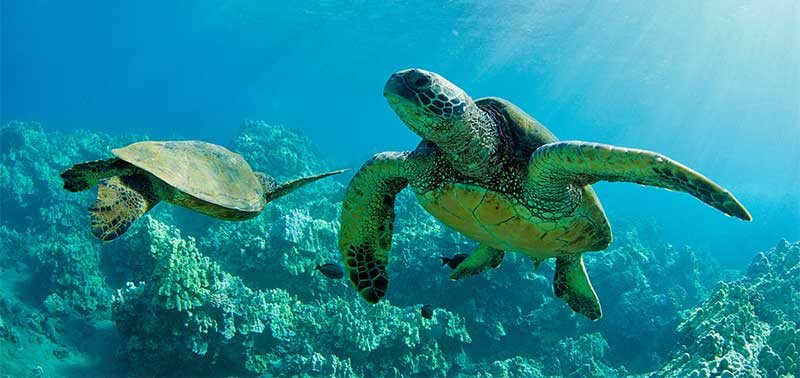
Sea turtles, like these Green Sea Turtles in Hawaii, may use the same resting areas on a daily basis. Where populations are reasonably dense, turtles may see and sometimes interact with the same other turtles every day over long periods of time. Some observers suggest that a social structure may develop among turtles that share a habitat.
Sightings of “flotillas” of Olive Ridleys and Kemp’s Ridleys at sea suggest that they might migrate in groups. Mass migrations may have occurred in other species when they were more abundant. There have been a few reports of pairs of tagged females of various species repeatedly emerging to nest close together, nearly simultaneously, at intervals of two to three years. Small groups of olive Ridleys also have been found nesting together in successive months. However, Olive Ridleys that nested together in groups were found to migrate to separate feeding areas afterwards, and green turtles that live close together on their feeding grounds in Hawaii migrate separately to the breeding area. The possibility of long-term social bonds among sea turtles is intriguing, but without solid evidence at present.

